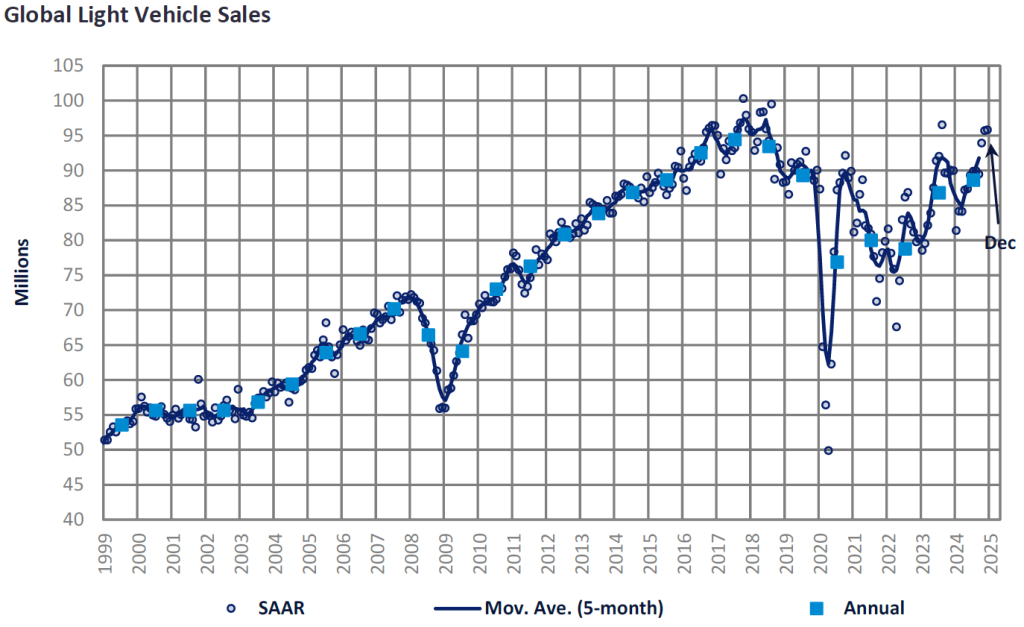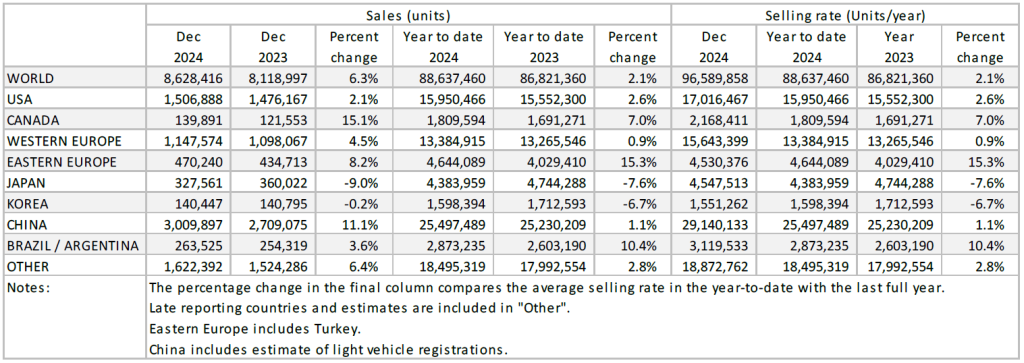In December, the Global Light Vehicle (LV) selling rate stood at 97 million units/year, marking a slight improvement from November and a robust conclusion to 2024. Market volumes experienced a strong growth of 6% YoY for the month. Overall, for the full year, global sales totalled 89 million units, reflecting a 2% increase from the previous year.

The key markets of US, China and Western Europe, were comfortably higher YoY. In the US, total year sales stood at 16 million units, the best since the pandemic, while sales in Western Europe improved slightly from previous lackluster results. China’s car market performed well as government incentive, scrappage subsidies, and strong demand for NEVs helped aid consumer demand.

North America
The US Light Vehicle market grew by 2.1% YoY in December 2024, reaching 1.50 million units. As sales ramped up through Q4, the selling rate jumped to 17.0 million units/year in December, up from the 16.7 million units/year reported in November. Looking at 2024 as a whole, sales totaled 16.0 million units, indicating a YoY gain of 2.6% YoY. This was the best result since the pandemic, but still 1 million units below 2019’s total. Average transaction prices continued to grow in December 2024, to US$46,389, up by US$1,049 from November. On the other hand, incentives saw a small increase to US$3,345, in an effort to combat the elevated transaction prices.
In December, Canadian Light Vehicle sales reached a hair under 140k units, marking an increase of 15.1% YoY. As sales picked up at the end of 2024, the selling rate reached 2.2 million units/year, up from 1.9 million units/year in November. Looking at Mexico, sales expanded by 7.3% YoY in December 2024 to 153k units. The selling rate dropped to 1.36 million units/year, from 1.51 million units/year recorded in November, but 2024 as a whole saw YoY growth of 12.2%, to 1.52 million units.
Europe

US Tariffs are shifting - will you react or anticipate?
Don’t let policy changes catch you off guard. Stay proactive with real-time data and expert analysis.
By GlobalDataThe LV selling rate for Western Europe continued the growth seen in previous months as it increased to 15.6 million units/year. Overall, for the year, the market was up by 1% YoY with a total of 13.4 million units sold. We expect growth to uptick in 2025 with further interest rate cuts and the release of new, more competitively priced models. Despite this, Europe continues to face numerous political and economic headwinds, especially concerning EV adoption.
The LV selling rate for Eastern Europe stood at 4.5 million units/year in December. 470k units were sold, an 8% increase YoY. Russian sales continued to expand YoY in December, with strong domestic production offsetting the decline in imports caused by the government hiking up the vehicle recycling fee in October. Sales in Turkey continue to operate at strong levels by historical comparison, with 1.2 million LVs again sold in 2024.
China
Preliminary data indicates that China’s domestic market finished 2024 on a solid footing. The December selling rate (which is based on wholesales) is estimated to be 29.1 million units/year, virtually unchanged from November’s upwardly revised 29 million units/year. Inventory levels at dealerships jumped in November after four straight months of sharp drops, which seemed to have prevented a further increase in deliveries from OEMs to dealerships in the final month of 2024, despite the expiry of the scrapping subsidy program on 31 December. In full-year 2024, total Light Vehicle sales are estimated to have increased by 1% to 25.5 million units, the highest since 2018, supported by the scrapping subsidies, various incentives, and massive price cuts.
To help maintain the momentum in the market, the government has extended the scrapping subsidy program until the end of 2025 and also expanded the type of vehicles that qualify for the subsidies. In addition, the sales tax exemption for NEVs remains effective until the end of this year. As such, sales are expected to remain buoyant this year, led by strong NEV sales (which outsold ICEs in the Passenger Vehicle sector in H2 2024). Yet, global uncertainty and the still depressed property market present risks to the economy and the automotive market.
Other Asia
The Japanese market ended 2024 on a subdued note. The December selling rate was 4.55 million units/year, the second consecutive month of MoM decline after an exceptionally strong October. In full-year 2024, total Light Vehicle sales declined by 7.6% to only 4.38 million units, the lowest level since 2011 (the year of the Tohoku earthquake and tsunami), excluding the pandemic-distorted 2021 and 2022. Such a dismal performance can be attributed mainly to supply shortages caused by the vehicle certification issues. Persistent inflation, a weak yen, and falling real wages also eroded consumers’ purchasing power.
Amidst the political turmoil, the Korean market lost momentum. The December selling rate was 1.55 million units/year, down nearly 8% from a strong November. The unions staged a one-time partial strike for a couple of days in December to demand President Yoon’s resignation but did not start a full-strike that they said they would. In full-year 2024, total LV sales were slightly below 1.6 million units (-6.7%), the worst result since 2013. Among the factors behind the disappointing result were the pull-ahead effect of the temporary tax cut in 2023, high financing rates, and the aging model cycle in the LCV sector. LCV sales were particularly weak, falling by 23% in 2024.
South America
Brazilian Light Vehicle sales reached 244k units in December, growing by 2.9% YoY. The selling rate slowed in December to 2.65 million units/year, down from 3.0 million units/year reported in November, and the lowest rate since August. Looking at the full year, sales expanded by 14.0% YoY in 2024, reaching 2.48 million units. While sales are still well below the 3 million units/year levels seen between 2009 and 2014, it is noteworthy that 2024 sales were the best since that period, with the sole exception of 2019.
In Argentina, Light Vehicle sales reached 19.8k units in December 2024, expanding by 13.8% YoY. The selling rate marginally slowed in December to 465k units, from 469k units/year in November. A weak Q1 made full-year growth extremely challenging in 2024, although the market notably strengthened as the year progressed, finishing with sales of 390k units, down by 8.1% YoY.

This article was first published on GlobalData’s dedicated research platform, the Automotive Intelligence Center.




